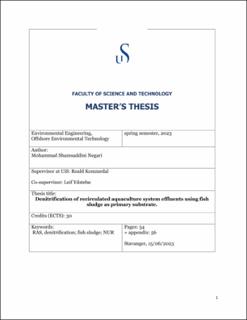| dc.description.abstract | Recirculating Aquaculture System (RAS) is a technology in which water is reused after different
biological and mechanical treatment steps in fish farming. RAS produces a nitrate rich water
effluent containing approximately 70-100 mg NO3/l, and a typical plant will have to offload
between 50-100 kg NO3-N/d which needs to be denitrified before release to the marine
environment to avoid eutrophication. Denitrification is a heterogenic process whereby reduced
substrates (primarily organic, but also some reduced inorganic salts, like H2S and Fe2+, may serve
as electron donors) are oxidized anoxically by reduction of NO3 and NO2 to N2. Organic substrates
may come from external sources (easily biodegradable substrateslike acetate or methanol) or from
internal, like the collected fish waste sludge containing feces and feed pellet residuals. Fish waste
sludge is mainly particulate slowly biodegradable, and hydrolysis is necessary for use as C-source
for denitrification. Fish sludge has been considered waste in the fish farming industries. Therefore,
it is free, and applying it to run RAS is a resource recovery process. The kinetics (reaction rate) of
denitrification using fish sludge is dependent on the chemical oxygen demand (COD) level; slowly
biodegradable CODs (sbCODs) should be converted to readily biodegradable CODs (rbCODs) to
provide the nitrate uptake process.
Raw fish sludge was step-fed once or twice a day to a batch reactor containing substrate adapted
activated sludge loaded with an initial nitrate concentration of 360 mg/l. Fish sludge
characterization wet analysis was done on three different sludge batches and were compared. Two
fermentation tests at 12 and 20 ℃ were done on fish sludge to investigate the effect of fermentation
on biodegradability of fish sludge. Biomass specific nitrate uptake rates (NUR) were measured by
an ion selective electrode, and substrate degradability and was estimated. NUR was also estimated
using an equivalent initial COD concentration of acetate, and maximum NUR rates using fish
sludge and fermented fish sludge were evaluated relative to the acetate driven denitrification rate.
Fish sludge COD were split into three biodegradable fractions (easily biodegradable, slowly
biodegradable, and slowly biodegradable particulate) based on NUR profiles, and their
corresponding COD estimated using typical denitrifying yield factors.
The observed acetate specific denitrification rate was 3.64 mg NO3-N/g VSS. h while the fish
sludge rates were estimated to 1.2, 0.9 and 0.2 mg NO3-N/g VSS. h for the easily, slowly, and
particulate degradable COD fractions respectively. Additionally, the effect of fermentation during
anaerobic storages (over seven days) on sludge characteristics and volatile fatty acid production
was investigated and the specific denitrification rate of settled and supernatant fermented sludge
for easily degradable CODs was 3 and 2.2 mg NO3-N/g VSS. h.
We conclude that direct use of fish sludge for denitrification of RAS effluents is possible, but
design and operation would have to allow for the relative slow kinetics of the process,
hypothetically limited by hydrolysis of slowly biodegradable dissolved and particulate COD
fractions, which could be accelerated through fermentation. | |
